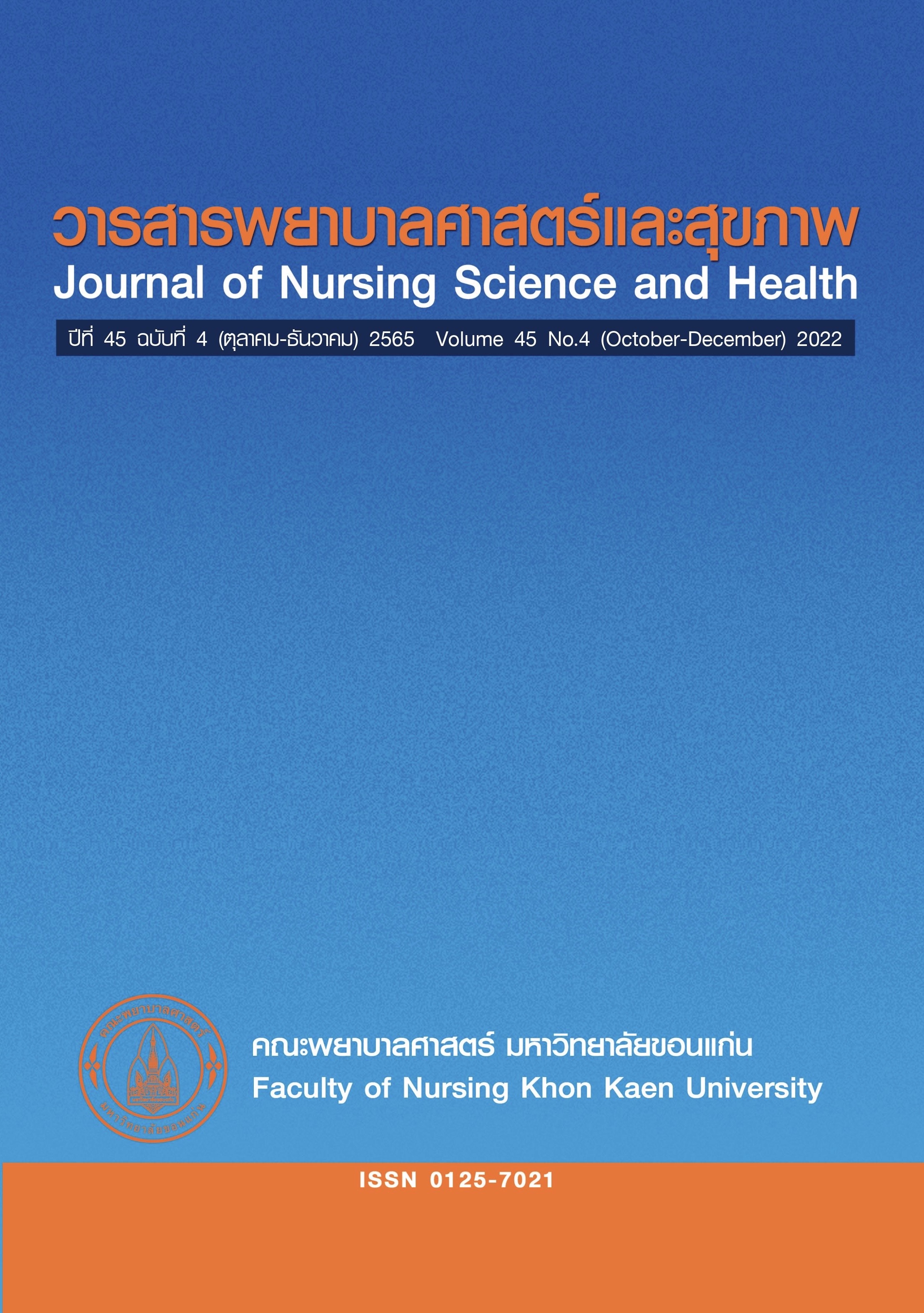ผลของการสวดมนต์และทำสมาธิต่อคุณภาพชีวิตและการควบคุมอารมณ์ในผู้ป่วยวัยรุ่นโรคมะเร็ง
คำสำคัญ:
การควบคุมอารมณ์, การสวดมนต์และทำสมาธิ, คุณภาพชีวิต, วัยรุ่นโรคมะเร็งบทคัดย่อ
ผู้ป่วยวัยรุ่นโรคมะเร็งมักมีอารมณ์แปรปรวนและหงุดหงิดง่าย ส่งผลให้มีคุณภาพชีวิตลดลง การวิจัยกึ่งทดลองแบบกลุ่มเดียววัดผลก่อนและหลังการทดลองนี้มีวัตถุประสงค์เพื่อศึกษาผลของการสวดมนต์ร่วมกับการทำสมาธิต่อคุณภาพชีวิตและการควบคุมอารมณ์ในผู้ป่วยวัยรุ่นโรคมะเร็ง อายุ 10-19 ปี เลือกกลุ่มตัวอย่างแบบเฉพาะเจาะจง จำนวน 12 คน ที่เข้ารับการรักษาที่หอผู้ป่วยเคมีบำบัด แผนกกุมารเวชกรรม โรงพยาบาลศรีนครินทร์ ระหว่างเดือนมิถุนายนถึงเดือนสิงหาคม พ.ศ.2562 เครื่องมือการวิจัย คือ วีดีโอสวดมนต์ คู่มือสวดมนต์และทำสมาธิ
เครื่องมือเก็บรวบรวมข้อมูล คือ แบบสอบถามคุณภาพชีวิตของผู้ป่วยวัยรุ่นโรคมะเร็ง (CVI=.95, Cronbach’ alpha coefficient=.83) และแบบสอบถามการควบคุมอารมณ์ของวัยรุ่นโรคมะเร็ง (CVI=.93, Cronbach’ alpha coefficient=.70) กลุ่มตัวอย่างได้รับการสอนสาธิตการสวดมนต์และทำสมาธิแบบกลุ่มจากผู้วิจัยขณะที่นอนโรงพยาบาล 3 วัน เมื่อกลับบ้านกลุ่มตัวอย่างสวดมนต์และทำสมาธิต่อเนื่องทุกวันจนครบ 4 สัปดาห์ ผู้วิจัยโทรศัพท์ติดตามกลุ่มตัวอย่างทุกวัน และติดตามสอบถามผู้ดูแล สัปดาห์ละ 1 ครั้ง เมื่อครบ 4 สัปดาห์ นัดกลับมาโรงพยาบาลทำแบบสอบถามหลังการทดลอง วิเคราะห์ข้อมูลด้วยสถิติเชิงพรรณนาและ paired t-test
ผลการวิจัยพบว่า ผู้ป่วยวัยรุ่นโรคมะเร็งมีอายุเฉลี่ย 14.85 ปี (S.D.=1.98) ส่วนใหญ่ได้รับการวินิจฉัยเป็นโรคมะเร็งกระดูกและกล้ามเนื้อ (ร้อยละ 41.70) หลังการสวดมนต์และทำสมาธิผู้ป่วยวัยรุ่นโรคมะเร็งมีคะแนนเฉลี่ยคุณภาพชีวิตและคะแนนเฉลี่ยการควบคุมอารมณ์หลังการทดลองสูงกว่าก่อนการทดลองอย่างมีนัยสำคัญทางสถิติ (p<.05) ผลการศึกษาครั้งนี้สรุปได้ว่า การสวดมนต์ร่วมกับการทำสมาธิช่วยให้ผู้ป่วยวัยรุ่นโรคมะเร็งมีคุณภาพชีวิตและการควบคุมอารมณ์ที่ดีขึ้น พยาบาลควรนำการสวดมนต์และทำสมาธิไปใช้ในการส่งเสริมคุณภาพชีวิตและการควบคุมอารมณ์ในผู้ป่วยวัยรุ่นโรคมะเร็งต่อไป
เอกสารอ้างอิง
SiegelRL,MillerKD,JemalA.Cancerstatistics, 2019. CA Cancer J Clin 2019;69(1):7-34.
Talukder MDH, Islam M, Kamal M, Laila N, Shihabuddin D. Hospital cancer registry report, NICRH, Dhaka 2015-2017; 2020.
Bellizzi KM, Smith A, Schmidt S, Keegan THM, Zebrack B, Lynch CF, et al. Positive and negative psychosocial impact of being diagnosed with cancer as an adolescent or young adult. Cancer 2012;118(20):5155–62.
Pan HT, Wu LM, Wen SH. Quality of life and its predictors among children and adolescents with cancer. Cancer Nurs 2017;40(5):343–51.
Thunyasiri S. Relationships among fatigue, management of fatigue and quality of life in pediatric oncology patients receiving chemotherapy [Internet]. [Bangkok]: Mahidol University; 2010. Available from: https://doi.nrct.go.th/ListDoi/listDetailResolve_DOI= 10.14457/MU.the.2010.7 (in Thai)
Punthmatharith B, Buddharat U, Wattanasit P. Quality of life and factors influencing quality of life of cancer children in southern Thailand. Songkla Med J 2008;26(5):501–11. (in Thai)
Tathong B, Seepan K, Acharaporn S. Factor influencing uncertainty in illness among children with cancer receiving chemotherapy. Nurs J (Manila) 2012;39(1):77–90.
DeRouen MC, Smith AW, Tao L, Bellizzi KM, Lynch CF, Parsons HM, et al. Cancer-related information needs and cancer’s impact on control over life influence health-related quality of life among adolescents and young adult swith cancer. Psychooncology 2015;24(9): 1104-15.
Ketkaew K, Patoomwan, A, Kongsaktrakol C. Perceived need and satisfied needs of adolescents with cancer during hospitalization: One year post-diagnosis. Thai Cancer J 2014;34(2):56–67. (in Thai)
Park EM, Rosenstein DL. Depression in adolescents and young adults with cancer. Dialogues Clin Neurosci 2015;17(2):171–80.
Fang F, Fall K, Mittleman MA, Sparén P, Ye W,Adami HO, et al. Suicide and cardiovascular death after a cancer diagnosis. N Engl J Med 2012;366(14):1310–8.
Albrecht TA, Rosenzweig M. Distress in patients with acute leukemia: A concept analysis. Cancer Nurs 2014;37(3):218–26.
Fardell J. E, Vetsch J, Trahair T, Mateos MK, Grootenhuis MA, Touyz LM, et al. Health-related quality of life of children on treatment for acute lymphoblastic leukemia: A systematic review. Pediatr Blood Cancer 2017;64(9):e26489. doi:10.1002/pbc.26489.
Nayiager T, Anderson L, Cranston A, Athale U, Barr RD. Health-related quality of life in long-term survivors of acute lymphoblastic leukemia in childhood and adolescence. Qual Life Res Int J Qual Life Asp Treat Care Rehabil 2017;26(5):1371–7.
Varni JW, Seid M, Rode CA. The PedsQL: Measurement model for the pediatric quality of life in ventory. Med Care 1999;37(2):126–39.
Varni JW, Limbers CA. The Pediatric Quality of Life Inventory: Measuring pediatric healthrelated quality of life from the perspective of children and their parents. Pediatr Clin North 2009;56(4):843-63. Available from: https://doi.org/10.1016/j.pcl.2009.05.016.
Thai Pediatric Oncology Group. National protocol for the treatment of children cancers. Bangkok: M Print; 2016. (in Thai)
Buckner CA, Lafrenie RM, Dénommée JA, Caswell JM, Want DA. Complementary and alternative medicine use in patients before and after a cancer diagnosis. Curr Oncol Tor Ont 2018; 25(4):e275-81.
Triamchaisri SKT. Mechanism of Meditation [Internet]. Scribd; 2018 [updated 2018 Sep 20; [cited 2021 Oct 27th]. Available from: https://kku.world/m4h4v
Lopsunthorn N, Nimit-Arnun N, Hoontrakul S. The effects of cancer-related fatigue symptom management program through walking exercise and pray therapy on quality of life of breast cancer patients. J R Thai Army Nurses 2018;19(Suppl):88-99. (in Thai)
Pukahuta P, Phutthikhamin T. The effects of therapeutic prayer on anxiety and spiritual well-being in breast cancer patients in diagnostic phase. J Nurs Health Care 2012;30(2):122–30. (in Thai)
Matchim Y, Kongsuwan W, Nilmanat K. Prayer experience in cancer patients: A phenomenology study. Songklanagarind J Nurs 2016;36(3):23–35. (in Thai)
Kumari S, Ghosh S. Effect of cyclic meditation on quality of life and perceived stress in female adolescence. Int J Educ Psychol Res 2015;1(3):238-40.
Marker AM, Steele RG, Noser AE. Physical activity and health-related quality of life in children and adolescents: A systematic review and meta-analysis. Health Psychol Off J Div Health Psychol Am Psychol Assoc 2018;37(10):893–903.
Nunes MDR, Jacob E, Bomfim EO, Lopes-Junior LC, de Lima RAG, Floria-Santos M, et al. Fatigue and health related quality of life in children and adolescents with cancer. Eur J Oncol Nurs Off J Eur Oncol Nurs Soc 2017;29:39–46.
Janmanee A. Effect of anapanasati meditation training and autogenic training on attention levels of children with risk for attention deficit. J Police Nurses 2014;6(1):56–70. (in Thai)
Dimidjian S, Segal ZV. Prospects for a clinical science of mindfulness-based intervention. Am Psychol 2015;70(7):593-620.
Levine EG, Aviv C, Yoo G, Ewing C, Au A. The benefits of prayer on mood and well-being of breast cancer survivors. Support Care in Cancer 2009;17(3):295-306.
Astin JA, Shapiro SL, Eisenberg DM, Forys KL. Mind-body medicine: State of the science, implications for practice. JABFP 2003;16(2):131-47.
Taber KS. The Use of Cronbach’s alpha when developing and reporting research instruments in science education. Res Sci Educ 2018;48:1273–96. https://doi.org/10.1007/s11165-016-9602-2
Khumtaveeporn P, Choocherd P, Sythipong S. Comparison between praying and listening to the pray on stress and quality of sleep in breast cancer patients. J R Thai Army Nurses 2014;15(2):386-94. (in Thai)
ดาวน์โหลด
เผยแพร่แล้ว
รูปแบบการอ้างอิง
ฉบับ
ประเภทบทความ
สัญญาอนุญาต
ลิขสิทธิ์ (c) 2022 วารสารพยาบาลศาสตร์และสุขภาพ

อนุญาตภายใต้เงื่อนไข Creative Commons Attribution-NonCommercial-NoDerivatives 4.0 International License.
วารสารพยาบาลศาสตร์และสุขภาพเป็นเจ้าของลิขสิทธิ์ในการเผยแพร่ผลงานที่ตีพิมพ์ห้ามผู้ใดนำบทความที่ได้รับการตีพิมพ์ในวารสารพยาบาลศาสตร์และสุขภาพไปเผยแพร่ในลักษณะต่าง ๆ ดังนี้ การนำบทความไปเผยแพร่ออนไลน์ การถ่ายเอกสารบทความเพื่อกิจกรรมที่ไม่ใช่การเรียนการสอน การส่งบทความไปตีพิมพ์เผยแพร่ที่อื่น ยกเว้นเสียแต่ได้รับอนุญาตจากวารสารพยาบาลศาสตร์และสุขภาพ



